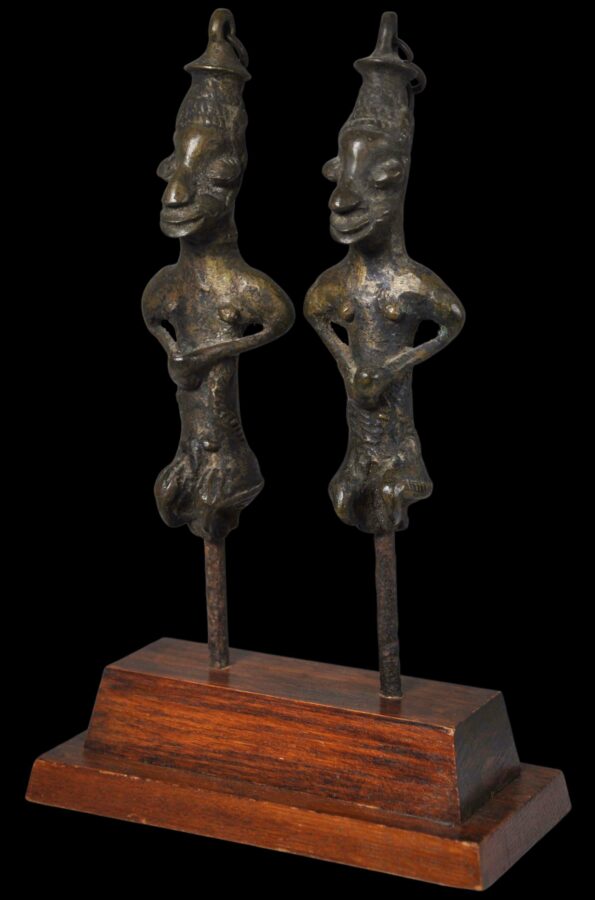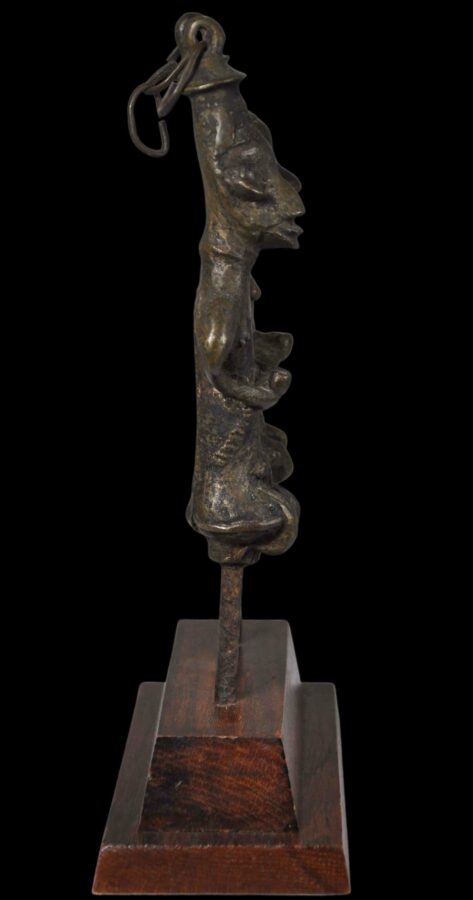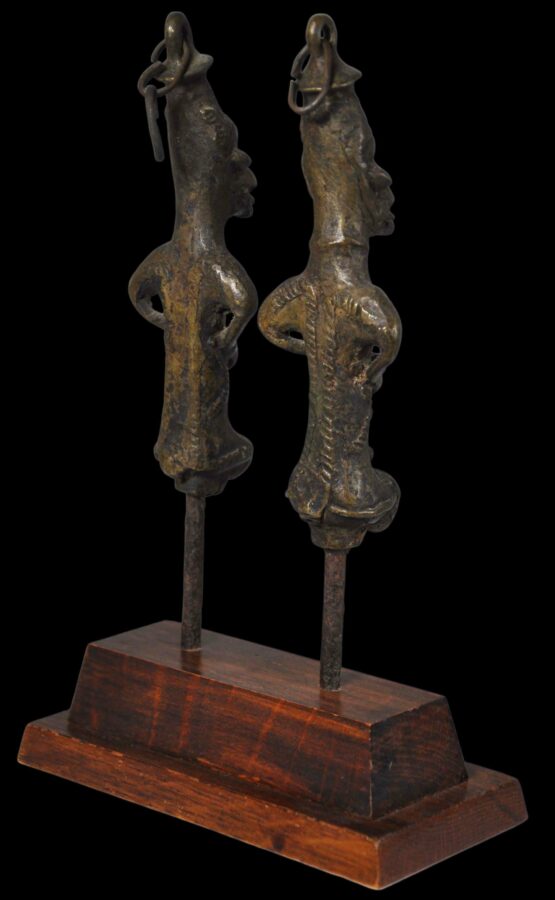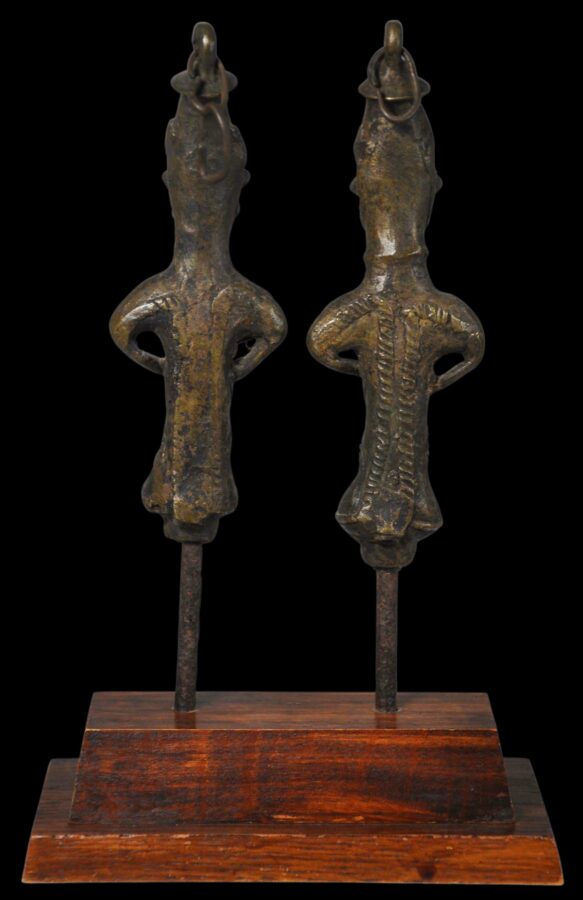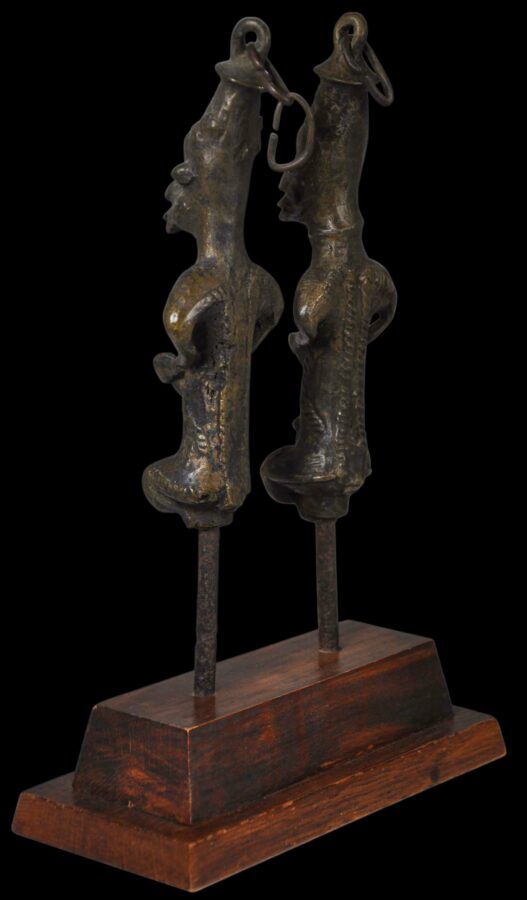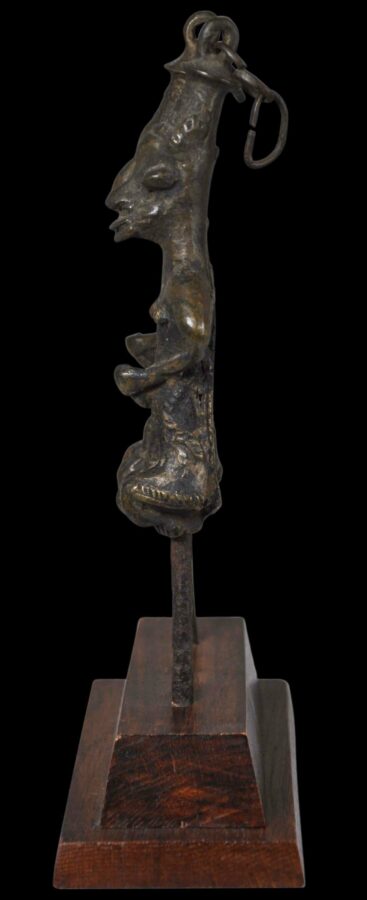Enquiry about object: 6653
Pair of Yoruba Bronze Ogboni Initiate’s Eden Staves
Yoruba People, Nigeria 19th century
height (with stand): 24.3cm, weight (with stand): 684g
Provenance
UK art market
This pair of figures known as edan have been cast in bronze, and were designed to be worn on either end of a chain that was draped over each shoulder and from behind the neck of an Ogboni initiate as symbols of rank, at society meetings and ceremonies. One staff depicts a male and the other a female. The chain would pass through loops to the tops of the heads of the figures.
The figures represent Onile, the owner of the earth, in both male and female form. They have characteristic Yoruba features: almond-shaped eyes, flared nostrils and fine, protruding lips. Both figures have tall, conical headdresses. The faces are intended to convey wisdom and authority.
The two have a superb dark and glossy patina and contours softened by age and ritual use.
Edan are among the most fascinating sculptured objects in Yoruba culture. They are presented to an initiate into the higher ranks of a secret society, Ogboni or Oshugbo. Ogboni is one of the most prominent Yoruba religious cult societies, which worships Onile. Its prime function is to harmonise all spirits and forces of nature. It is lead by the eldest and wisest man and woman from the community.
The non-rusting character of bronze and brass symbolises immortality – the desire for longevity and well-being. The union of the male and female figures by a chain represents the duality of Onile. Ogboni venerates Onile to ensure human survival, peace, happiness, and social stability in the community.
The edan are used in five main functions: judicial, oracular, healing, protective, and communication/surveillance (Roache, 1971). For its oracular role, an edan set is required to be present with its owner in ifa divination for predicting the owner’s future. The Ogboni society has its own odu, a set of sacred verses of the spiritual and ethical tradition of ifa, predictions; that relate to both mundane and spiritual prescriptions. For the healing role, the edan are sometimes shaped like a spoon for medicine preparation. For the protective role, the edan are worn or carried to keep the bearer from harm and witchcraft. For the communication and surveillance role, the edan are believed to have the power to travel in the form of a bird to disseminate messages as well as to watch over people.
According to Williams (1960), the Ogboni believed that a union of two Ogboni becomes three. The third entity is a mystery or a secret that sprung from the union of male and female as demonstrated in the edan. The secret may refer to the completion of life: from kneeling before the High God or Father Olodumare, receiving a personal destiny ori, entering the world of sexual, social, political and religious differentiation and opposition (Fagg & Pemberton 1982). The edan often was placed in places of conflict to demonstrate unity, reconciliation and adjudication of differences among mankind, and ultimately with the earth. The Ogboni society acted as a town council, a civic court, and even controlled over regents in local monarchies. Membership implied power and prestige, and this status generally was reinforced through the commissioning of religious and courtly paraphernalia. Williams (1964) argues that Ogboni art was absolute, static and linear as opposed to the formal theme of Yoruba carving: abstract, dynamic and architectonic. The membership is limited to the few people who achieve distinction through their profession and who prove to be of high integrity. Ogboni societies still exist among more traditional Yoruba today, but not to the same extent.
The pair of staves here are fixed to an attractive wooden display stand.

Above: an early photograph of an Ogboni wearing related examples of edan around his neck.
Scroll down for more images.
References
Bacquart, J. B., The Tribal Arts of Africa, Thames & Hudson, 1998.
Fagg, W. & Pemberton, J. III., Yoruba: Sculpture of West Africa, Collins, 1982.
Roache, L.E., ‘Psychophysical attributes of the Ogboni Edan’, in African Arts, 14(3): 48–53, 1971.
Williams, D., ‘The Iconology of the Yoruba Edan Ogboni’, in Africa: Journal of the International African Institute, Cambridge University Press and International African Institute, 1964.
Williams, P. M., ‘The Yoruba Ogboni Cult in Oyo’ in Africa: Journal of the International African Institute, Cambridge University Press and International African Institute, 1960.





